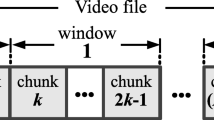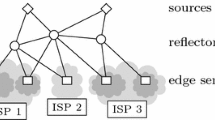Abstract
Providing cost‐effective video‐on‐demand (VOD) services necessitates reducing the required bandwidth for transporting video over high‐speed networks. In this paper, we investigate efficient schemes for transporting archived MPEG‐coded video over a VOD distribution network. A video stream is characterized by a time‐varying traffic envelope, which provides an upper bound on the bit rate. Using such envelopes, we show that video streams can be scheduled for transmission over the network such that the per‐stream allocated bandwidth is significantly less than the source peak rate. In a previous work [13], we investigated stream scheduling and bandwidth allocation using global traffic envelopes and homogeneous streams. In this paper, we generalize the scheduling scheme in [13] to include the heterogeneous case. We then investigate the allocation problem under window‐based traffic envelopes, which provide tight bounds on the bit rate. Using such envelopes, we introduce three stream‐scheduling schemes for multiplexing video connections at a server. The performance of these schemes is evaluated under static and dynamic scenarios. Our results indicate a significant reduction in the per‐stream allocated bandwidth when stream scheduling is used. While this reduction is obtained through statistical multiplexing, the transported streams are guaranteed stringent, deterministic quality of service (i.e., zero loss rate and small, bounded delay). In contrast to video smoothing, our approach requires virtually no buffer at the set‐top box since frames are delivered at their playback rate.
Similar content being viewed by others
References
K.C. Almeroth and M.H. Ammar, The use of multicast delivery to provide a scalable and interactive video-on-demand service, IEEE Journal on Selected Areas in Communications 14(6) (1996) 1110-1122.
W. Feng, F. Jahanian and S. Sechrest, An optimal bandwidth allocation strategy for the delivery of compressed prerecorded video, Technical Report CSE-TR260-95, Department of EECS, University of Michigan, Ann Arbor (1995).
W.-C. Feng and S. Sechrest, Smoothing and buffering for the delivery of prerecorded compressed video, in: IS&T/SPIE Multimedia Computing and Networking (February 1995) pp. 234-244.
M.W. Garrett and M. Vetterli, Congestion control strategies for packet video, in: Proceedings of 4th International Workshop on Packet Video, Kyoto, Japan (August 1991).
M.W. Garrett and W. Willinger, Analysis, modeling, and generation of self-similar VBR video traffic, in: Proceedings of the SIGCOMM '94 Conference (September 1994) pp. 269-280.
M. Graf, VBR video over ATM: Reducing network resource requirements through endsystem traffic shaping, in: Proceedings of IEEE INFOCOM '97 (1997) pp. 48-57.
C. Huang, M. Devetsikiotis, I. Lambadaris and A. Kaye, Modeling and simulation of self-similar variable bit rate compressed video: A unified approach, in: Proceedings of the SIGCOMM '95 Conference (1995) pp. 114-125.
ISO CD11172-2: Coding of moving pictures and associated audio for digital storage media at up to about 1.5 mbits/s, ISO/MPEG (November 1991).
ISO CD11172-2: Coding of moving pictures and associated audio, ISO/MPEG II (December 1992).
E.W. Knightly, D. Wrege, J. Liebeherr and H. Zhang, Fundamental limits and tradeoffs of providing deterministic guarantees to VBR video traffic, in: Proceedings of the ACM Sigmetrics/Performance '95 Conference (May 1995) pp. 98-107.
E.W. Knightly and H. Zhang, Traffic characterization and switch utilization using a deterministic bounding interval dependent traffic model, in: Proceedings of IEEE INFOCOM '95 (1995) pp. 1137-1145.
M. Krunz, R. Sass and H. Hughes, Statistical characteristics and multiplexing of MPEG streams, in: Proceedings of the IEEE INFOCOM '95 Conference, Boston (April 1995) pp. 455-462.
M. Krunz and S.K. Tripathi, Impact of video scheduling on bandwidth allocation for multiplexed MPEG streams, ACM Multimedia Systems Journal 5(6) (1997) 347-357.
S.S. Lam, S. Chow and D.K.Y. Yau, An algorithm for lossless smoothing for MPEG video, in: Proceedings of the ACM SIGCOMM '94 Conference (August 1994) pp. 281-293.
V.O.K. Li, W. Liao, X. Qiu and E. Wong, Performance model of interactive video-on-demand systems, IEEE Journal on Selected Areas in Communications 14(6) (1996) 1099-1109.
J.M. McManus and K.W. Ross, Video-on-demand over ATM: Constant-rate transmission and transport, IEEE Journal on Selected Areas in Communications 14(6) (1996) 1087-1098.
J.-P. Nussbaumer, B.V. Patel, F. Schaffa and J.P.G. Sterbenz, Networking requirements for interactive video on demand, IEEE Journal on Selected Areas in Communications 13(5) (1995) 779-787.
T. Ott, T. Lakshman and A. Tabatabai, A scheme for smoothing delay-sensitive traffic offered to ATM networks, in: Proceedings of IEEE INFOCOM '92 (May 1992) pp. 776-785.
P.V. Rangan, H.M. Vin and S. Ramanathan, Designing an on-demand multimedia service, IEEE Communications Magazine (July 1992) 56-64.
A.R. Reibman and A.W. Berger, Traffic descriptors for VBR video teleconferencing over ATM networks, IEEE/ACM Transactions on Networking 3(3) (June 1995) 329-339.
D.J. Reininger, D. Raychaudhuri and J.Y. Hui, Bandwidth renegotiation for VBR video over ATM networks, IEEE Journal on Selected Areas in Communications 14(6) (1996) 1076-1086.
M. Reisslein and K.W. Ross, Join-the-Shortest-Queue prefetching for VBR video on demand, in: Proceedings of International Conference on Networking Protocols (1997).
J.D. Salehi, Z.-L. Zhang, J.F. Kurose and D. Towsley, Supporting stored video: Reducing rate variability and end-to-end resource requirements through optimal smoothing, in: Proceedings of the ACM Sigmetrics/Performance '96 Conference (May 1996).
S. Sampath Kumar, S. Ramanathan and P.V. Rangan, Technologies for distribution of interactive multimedia to residential subscribers, in: Proceedings of the 1st Int. Workshop on Community Networking: Integrated Multimedia Services to the Home (July 1994) pp. 151-160.
N. Shroff and M. Schwartz, Video modeling within networks using deterministic smoothing at the source, in: Proceedings of IEEE INFOCOM '94, Vol. 1 (1994) pp. 342-349.
Author information
Authors and Affiliations
Rights and permissions
About this article
Cite this article
Krunz, M., Zhao, W. & Matta, I. Scheduling and bandwidth allocation for the distribution of archived video in VOD systems. Telecommunication Systems 9, 335–355 (1998). https://doi.org/10.1023/A:1019108209544
Issue Date:
DOI: https://doi.org/10.1023/A:1019108209544




